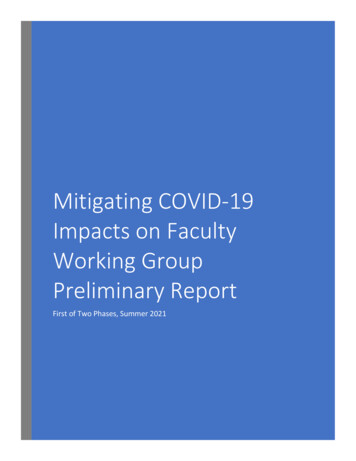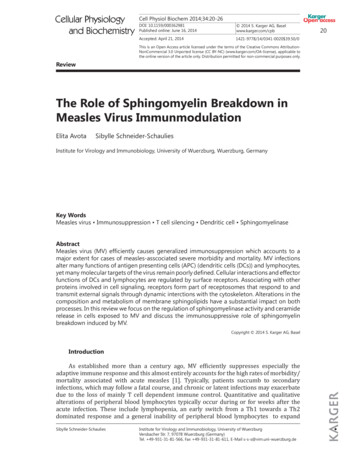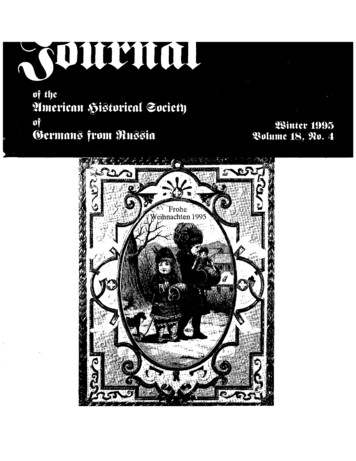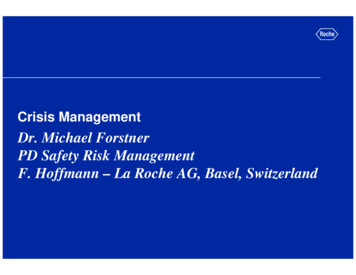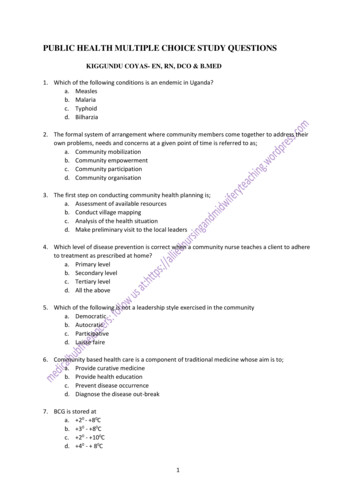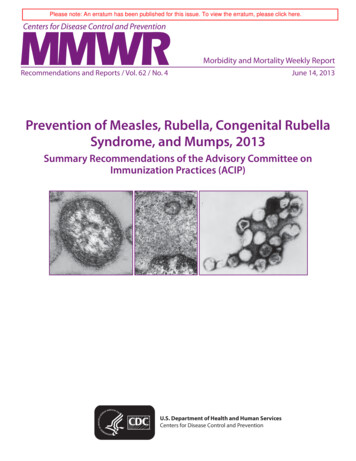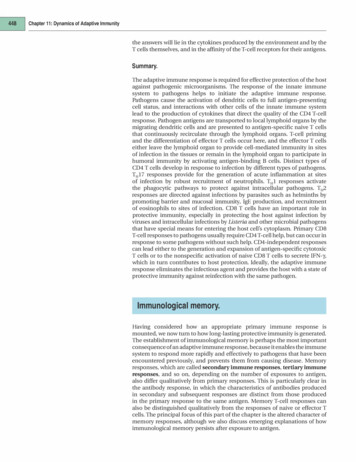
Transcription
June 13, 1997 / Vol. 46 / No. RR-11TMRecommendationsandReportsMeasles Eradication:Recommendations from a MeetingCosponsored by the World HealthOrganization, the Pan American HealthOrganization, and CDCU.S. DEPARTMENT OF HEALTH AND HUMAN SERVICESPublic Health ServiceCenters for Disease Controland Prevention (CDC)Atlanta, Georgia 30333
The MMWR series of publications is published by the Epidemiology Program Office,Centers for Disease Control and Prevention (CDC), Public Health Service, U.S. Department of Health and Human Services, Atlanta, GA 30333.SUGGESTED CITATIONCenters for Disease Control and Prevention. Measles eradication: recommendations from a meeting cosponsored by the World Health Organization, the PanAmerican Health Organization, and CDC. MMWR 1997;46(No. RR-11):[inclusivepage numbers].Centers for Disease Control and Prevention . David Satcher, M.D., Ph.D.DirectorThe material in this report was prepared for publication by:National Immunization Program .Walter A. Orenstein, M.D.DirectorEpidemiology and Surveillance Division . Stephen C. Hadler, M.D.DirectorThe production of this report as an MMWR serial publication was coordinated in:Epidemiology Program Office. Stephen B. Thacker, M.D., M.Sc.DirectorRichard A. Goodman, M.D., M.P.H.Editor, MMWR SeriesOffice of Scientific and Health Communications (proposed)Recommendations and Reports . Suzanne M. Hewitt, M.P.A.Managing EditorRobert S. Black, M.P.H.Project EditorMorie M. HigginsVisual Information SpecialistUse of trade names and commercial sources is for identification only and does notimply endorsement by the Public Health Service or the U.S. Department of Healthand Human Services.Copies can be purchased from Superintendent of Documents, U.S. GovernmentPrinting Office, Washington, DC 20402-9325. Telephone: (202) 512-1800.
Vol. 46 / No. RR-11MMWRiContentsIntroduction.2Definitions of Measles Elimination and Eradication.3Background .3Status of Global Measles Control .3Measles Elimination in Latin America, the English-SpeakingCaribbean, and Canada.6Measles Elimination in the United States.12Conclusions and Recommendations .15Feasibility of Measles Eradication .15Vaccination Strategies .16Surveillance Strategies .16Laboratory Strategies .17Response to Measles Outbreaks .17Obstacles to Eradication.18Discussion .18References.19
iiMMWRMay 27, 1997This report was prepared by the staffs of the following organizations:Expanded Programme on Immunization,World Health OrganizationSpecial Program for Vaccines and Immunization,Pan American Health OrganizationNational Immunization Program,Centers for Disease Control and PreventionTask Force for Child Survival and Development
Vol. 46 / No. RR-11MMWRiiiLIST OF PARTICIPANTSMeeting Moderators:Donald R. Hopkins, M.D., M.P.H.Neal Nathanson, M.D.Meeting Rapporteur:Alan R. Hinman, M.D., M.P.H.Al-Saleh, MussabMinistry of HealthKuwaitAlyward, BruceWorld Health OrganizationGeneva, SwitzerlandAndrus, JohnSout East Asia Regional Office,World Health OrganizationNew Delhi, IndiaAristeguieta, CarlosPan American Health OrganizationWashington, DCBeeler, JudyFood and Drug AdministrationRockville, MarylandBiellik, RobinAfrican Regional Office,World Health OrganizationBrazzaville, CongoBreman, JoelNational Institutes of HealthBethesda, MarylandCrippen, PeterBureau of ImmunizationNew York, New YorkCrouch, NormanMinnesota Public Health LabortoryMinneapolis, Minnesotade Quadros, CiroPan American Health OrganizationWashington, DCDowdle, Walter R.Task Force for Child Survival andDevelopmentAtlanta, GeorgiaDuclos, PhilippeLaboratory Centre for Disease ControlHealth CanadaOttawa, CanadaEggers, RudiDepartment of HealthPretoria, South AfricaFinger, ReginaldDepartment of Health ServicesFrankfort, KentuckyFisher, WillaBremerton-Kitsap County Health DistrictBremerton, WashingtonFoster, StanleyRollins School of Public HealthAtlanta, GeorgiaGaafar, TakyEastern Mediterranean Regional Office,World Health OrganizationAlexandria, EgyptGellin, BruceNational Institutes of HealthBethesda, MarylandHersh, BradleyPan American Health OrganizationWashington, DC
ivMMWRJune 13, 1997LIST OF PARTICIPANTS — ContinuedKatz, SamuelDuke University Medical CenterDurham, North CarolinaKuno-Sakai, HarumiTokai University School of MedicineTokyo, JapanMiller, MarkCVIGeneva, SwitzerlandMiyamura, TatsuoNational Institute of HealthTokyo, JapanMontesano, RaulSecretariate of HealthMéxico, D.F.MéxicoMurray, DennisMichigan State UniversityEast Lansing, MichiganNogueira, CristinaPan American Health OrganizationWashington, DCOlivé, Jean-MarcWorld Health OrganizationGeneva, SwitzerlandOtten, MacPan American Health OrganizationWashington, DCRenne, ToveStatens Serum InstitutCopenhagen, DenmarkRoure, ColetteEuropean Regional Office,World Health OrganizationCopenhagen, DenmarkSalisbury, DavidDepartment of HealthLondon, United KingdomSchmidt, TerryAlaska State Virology LaboratoryFairbanks, AlaskaSilveira, ClaudioPan American Health OrganizationWashington, DCSmith, NatalieCalifornia Department of Health ServicesBerkeley, CaliforniaStrassburg, MarcLos Angeles County ImmunizationProgramLos Angeles, CaliforniaTabony, LauraTexas Department of HealthAustin, TexasTimperi, Ralph J.Massachusetts Public Health LaboratoryBoston, MassachusettsWaterman, SteveCalifornia Deparment of Health ServicesBerkeley, California
Vol. 46 / No. RR-11MMWRLIST OF PARTICIPANTS — ContinuedCDC ParticipantsAlleman, MaryKolasa, MaureenAnderson, LarryKoops, GlenBellini, WilliamKuritsky, JoelBreiman, RobertLeBaron, CharlesBrink, EdwardLee, LisaCaceres, VictorLinkins, RobbCochi, SteveLivengood, JohnCordero, JoséLloyd, JeniferDeming, MichaelMackey, TremayneDietz, VanceMaes, EdmondDurry, EliasMahy, BrianDykewicz, ClareMcDade, JosephGindler, JacquelineNichols, WilliamGoettl, CarolOrenstein, WalterHadler, StephenOstroff, StephenHarpaz, RafaelO’Mara, DennisHeath, JanetPallansch, MarkHelfand, RitaPapania, MarkHeningburg, Anne-ReneeRainey, JeannetteHinman, AlanRazak, Myat H.Howard, Gary E. Jr.Redd, StephenHughes, JamesRedd, SusanHutchins, SonjaReef, SusanJafari, HamidRhodes, PhilKeegan, BobRodewald, LanceKew, OlenRosenthal, JorgeKhabbaz, RimaRota, JenniferKilgore, PaulRoy, Jeanv
viMMWRLIST OF PARTICIPANTS — ContinuedSales, Rose-MarieWainwright, SherrilynSpiegel, RichardWatson, JohnStrebel, PeterWharton, MelindaSutter, RolandWilliams, JoeTarande, ManzilaWing, JesseThomas, AnnYip, FuyuenJune 13, 1997
Vol. 46 / No. RR-11MMWRMeasles Eradication:Recommendations from a Meeting Cosponsored bythe World Health Organization, the Pan AmericanHealth Organization, and CDCSummaryRecent successes in interrupting indigenous transmission of measles virus inthe Americas and in the United Kingdom prompted the World Health Organization (WHO), Pan American Health Organization (PAHO), and CDC to convene ameeting in July, 1996 to consider the feasibility of global measles eradication.Presentations at the meeting included an overview of global measles controland elimination efforts; detailed reviews of successful measles elimination efforts in Latin America, the English-speaking Caribbean, Canada, and the UnitedStates; surveillance for clinical disease; laboratory tools for antibody detectionand virus identification; and other factors that might influence the feasibility ofdisease eradication. With this background information, meeting organizersasked participants to address five questions: Is global measles eradication feasible? Is measles eradication feasible with current vaccines? What are the appropriate vaccination strategies for measles eradication? How should surveillance for measles be carried out? What role should outbreak control play in the strategy to eliminate measles?Participants agreed that measles eradication is technically feasible with available vaccines and recommended adoption of the goal of global eradication witha target date during 2005-2010, with the proviso that measles eradication effortsshould not interfere with poliomyelitis eradication but should build on thesuccesses of the global Poliomyelitis Eradication Initiative. Although existingvaccines are adequate for eradication, vaccination strategies that rely on administration of a single dose of vaccine are not. In the Americas, sustainedinterruption of indigenous measles virus transmission has been achievedthrough a three-tiered vaccination strategy that includes a) “catch-up” vaccination of all persons aged 1–14 years, regardless of disease history or vaccinationstatus; b) “keep-up” vaccination of 90% of children in each successive birthcohort at age 12 months; and c) “follow-up” campaigns designed to vaccinateall persons within a specific age range whenever the number of susceptible persons in the preschool-aged population approximates the size of a typical birthcohort (in practice, every 3–5 years). In other regions, different strategies maybe optimal.Surveillance, a critical component of any strategy to eliminate or eradicatemeasles, has two functions: to assess the effectiveness of the measles elimination strategy and to detect circulation of measles virus in a population.1
2MMWRJune 13, 1997Systematic surveillance based on clinical diagnosis should be implementedearly in any measles elimination program. In countries attempting to eliminateindigenous measles, all isolated cases of measles and at least one case in eachchain of transmission should be confirmed by laboratory tests. Specimens forvirus isolation (e.g., urine, nasopharyngeal swabs, or blood) should be collectedin conjunction with field investigations. Vaccination campaigns generally havenot proved to be effective responses to measles outbreaks. Outbreaks should betreated as opportunities to reinforce surveillance and to identify measures toprevent future outbreaks.The major obstacles to measles eradication are not technical but perceptual,political, and financial. Measles is often mistakenly perceived as a mild illness.This misperception, which is particularly prevalent in industrialized countries,can inhibit the development of public and political support for the allocationof resources required for an effective elimination effort. The disease burden imposed by measles should be documented, particularly in industrializedcountries, so that this information can be used to educate parents, medical practitioners, public health workers, and political leaders about the benefits ofmeasles eradication.INTRODUCTIONDuring the early 1980s, in the aftermath of smallpox eradication, some scientistsand public health officials urged consideration of a global effort to eradicate measles (1 ). During the mid-1980s, however, the high level of population immunityrequired to interrupt measles virus transmission became clear, and the prospectof measles eradication seemed to recede (2 ). As recently as 1993, a task force on disease eradication declared measles “not now eradicable”(3 ). The major obstacles toeradication cited by the task force were the contagiousness of measles, the lack of avaccine that is effective among children aged 9 months (most of whom have maternal antibody to measles that protects them from disease but which also inhibits theimmune response to the vaccine virus), and the incorrect perception that measles is amild illness.Recent successes in implementing new approaches to control and eliminate measles virus transmission prompted the World Health Organization (WHO), the PanAmerican Health Organization (PAHO), and CDC to convene a meeting July 9–10, 1996,in Atlanta to reconsider the feasibility of global measles eradication. Among the participants were representatives of the sponsoring organizations, representatives ofregions and countries that have implemented measles elimination activities, and persons affiliated with WHO Regional Offices, local and state health departments in theUnited States, and universities. During the meeting, presenters reviewed vaccinationstrategies and achievements in measles control in the Caribbean and Latin America,Canada, and the United States.In addition, representatives of Denmark, Kuwait, Mexico, South Africa, and theUnited Kingdom described their recent efforts to control or eliminate measles transmission. In each of these countries, intensification of efforts to control measles hasbeen followed by sustained declines in the number of reported cases.
Vol. 46 / No. RR-11MMWR3Other presentations addressed surveillance for clinical disease and laboratory toolsfor virus identification and antibody detection. Information was presented concerningother factors that could potentially affect the feasibility of measles eradication (i.e.,the possible existence of nonhuman reservoirs for the virus, the possibility of transmission of measles from persons with asymptomatic measles infection, and thepossibility that vaccination-induced immunity to measles might wane with the passage of time).Based on this information and on subsequent discussion, meeting participantswere asked to address five questions: Is global measles eradication feasible? Is measles eradication feasible with current vaccines? What are the appropriate vaccination strategies for measles eradication? How should surveillance for measles be carried out? What role should outbreak control play in the strategy to eliminate measles?Discussion of these questions formed the basis for the conclusions and recommendations of the meeting. The rapporteur prepared a draft of the conclusions andrecommendations that was distributed and discussed in the final session of the 2-daymeeting. The discussion and subsequent modification of the draft ensured that thereport would reflect both points of consensus and the sense of discussionsamong participants.Definitions of Measles Elimination and EradicationTo facilitate communication among participants, working definitions of two important terms were developed during the meeting. Measles elimination refers to interruption of transmission in a sizable geographic area in which vaccination wouldnevertheless need to continue because of the continued threat of reintroduction of thevirus. Eradication, defined as the global interruption of measles transmission, represents the sum of successful elimination efforts in all countries. Once eradication isachieved, vaccination could be stopped without risk for measles outbreaks.BACKGROUNDThis section a) describes the status of global measles control; b) summarizesefforts to eliminate measles in Latin America, the English-speaking Caribbean, andCanada; and c) describes progress toward measles elimination in the United States.The summaries are based upon material presented at the meeting and have beenupdated by the presenters.Status of Global Measles ControlSince the inception of the World Health Organization’s Expanded Programmeon Immunization (EPI) in 1974, the numbers of cases and deaths attributed worldwideto measles have declined substantially, from an estimated 100 million cases and
4MMWRJune 13, 19975.8 million deaths in 1980 to an estimated 44 million cases and 1.1 million deaths in1995. In 1974, only 5% of the world’s children aged 12–23 months had been vaccinatedagainst measles. By the mid-1980s, measles vaccination coverage among childrenaged 12–23 months in developing countries had reached only 42%, largely becauseof the lack of infrastructure for delivering vaccines and the perception that measleswas not a serious public health problem (4 ). From 1985 through 1990, however,the number of measles cases reported worldwide declined by 56% as governments,international agencies and other organizations provided the human and financial resources needed to reach the global goal of 80% infant immunization coverage by theyear 1990 (WHO, unpublished data).Despite these achievements, measles remains one of the leading causes of childmortality in developing countries, responsible for approximately 10% of all deathsamong children aged 5 years (5 ). These deaths typically occur among young children in countries with low vaccination coverage levels. Even countries that haveachieved high levels of measles vaccination coverage and have recorded severalyears of low incidence frequently have experienced large measles outbreaks (6–9 ).On the basis of vaccination coverage, case fatality rates, and vaccine effectiveness,WHO estimates that by 1995 measles-associated morbidity and mortality had decreased by 78% and 88%, respectively, in comparison with the pre-vaccine era (WHO,unpublished data).Although these estimates demonstrate a marked reduction in the health burden ofmeasles, they also indicate that the mid-decade goals of reducing measles morbidityby 90% and measles mortality by 95% have not been met. Measles outbreaks havecontinued to occur because, even in countries with high vaccination coverage, theproportion of children susceptible to the disease increases over time and eventuallyreaches a level that sustains measles transmission. Ongoing measles outbreaks havebeen particularly problematic in developing countries. Low vaccination coverage hasbeen primarily responsible for these outbreaks. However, the practice of vaccinatingchildren aged 12 months has also contributed because the vaccine is less effectiveamong children of this age. (Vaccinating of children aged 12 months has also substantially reduced measles incidence in this age group, in which mortality from thedisease is highest.) Compared with vaccinating children aged 12 months, vaccinatingthose younger than 12 months hastens the accumulation of susceptible persons in thepreschool-aged population.In some developing countries, two-dose measles vaccination schedules were introduced to slow the increase of susceptible children by vaccinating those who hadmissed the first dose and providing protection to those who did not develop animmune response after a single dose of measles vaccine. This strategy has interrupted measles transmission in some industrialized countries that have achievedvaccination coverage levels exceeding 95% for both doses of vaccine. Attainment ofsuch high coverage levels required active follow-up of children who missed a scheduled dose (10 ). In developing countries, outbreaks have continued to occur aftertwo-dose schedules were implemented, because the second dose (scheduled at agesranging from 18 months to primary- or secondary school entry) seldom reached previously unvaccinated children, and coverage attained with the second dose is alwayslower than with the first dose (11 ).
Vol. 46 / No. RR-11MMWR5FIGURE 1. Reported incidence of measles — World Health Organization regions,1990–1995Reported A1992Year of AAAAAAAAAA19300,000AAAAWorld HealthAAAAAAAAAAAAAA AAA AAAAAAAAOrganization regionAAA AAA AAAA AAAAAAAAAAA AAA AAAA AAAA AAAAAAAAAAA AAAAAAAAAAAAAAAAA AAAAAAAAAAAAAAAAAAAAAAAAA AAAA AAAA AAAAAAAAAAAAAAAAAA AAAA AAAAAAAAAAAAAAAAAAAAAA AAAAAfricaAAAAAAAAAAAAAAAAAAAAAAAAAAAAAA AAAAAAAA AAAAAAAAAAAAAAAAAAAAAAAA AAAAAAAA AAAAAAAAAAA AAAAAAAAAAAAAAAAAAAAAA AAAA AAA AAAAAAAA AAAAWestern EuropeAAA AAAA AAA AAAAAAAAAAAAAAAAA AAAAAAAAAAAAAAASoutheastAsiaAAAA AAA AAAAAAAAAA AAAAAAAA AAAAAA AAAAAAAAAAAA AAAAAAWestern PacificAAAAAAEastern MediterraneanAAA AAAAAAAAA AAAAAAAAAAAmericasAAAA19400,000Since 1994, a strategy of limited vaccination campaigns targeting all children aged9 months to 5 years has been advocated to reduce measles morbidity and mortalityby reaching unvaccinated children in areas in which risk for measles is high (e.g.,large, densely populated urban and peri-urban centers)(12 ). This strategy is intendedto improve vaccination coverage and not necessarily to interrupt measles virus transmission. Several countries in WHO’s Southeast Asian Region (i.e., Bangladesh, India,Myanmar, and Nepal), and its Western Pacific Region (i.e., the Philippines) haveused the strategy with only modest success. Many children who were unvaccinatedbefore the campaigns remained unvaccinated afterward. In addition, poor case surveillance hindered efforts to evaluate the impact of the campaigns in reducing thedisease burden.The experience in the Philippines provides an example of these difficulties. Immediately after a measles vaccination campaign that targeted urban areas in that country,a measles epidemic occurred. The epidemic prompted a vaccination coverage survey,which indicated that the campaign had succeeded in vaccinating only 44% of previously unvaccinated children (Philippine Ministry of Health, unpublished data).Although vaccination campaigns limited to high-risk areas can help reduce morbidityand mortality caused by measles, they do not result in the sustained interruption ofmeasles virus transmission. Such campaigns must include provisions for vaccinatingpreviously unvaccinated children and improving surveillance so that the impact of thecampaign can be measured.The impact of measles vaccination has varied substantially among the six WHORegions (Figure 1). These interregional differences reflect disparities in routine immunization coverage levels and, more importantly, in the effectiveness of differentmeasles control strategies. Of the six WHO Regions, the most substantial progress in
6MMWRJune 13, 1997measles control has been achieved in the Americas, where most countries haveimplemented a strategy based on a one-time-only mass vaccination campaign acrossa wide age group. The goals of this strategy are to achieve a rapid reduction in thenumber of susceptible children in the population and to interrupt the transmission ofmeasles virus. To keep the susceptible population from exceeding the epidemicthreshold requires high routine coverage and periodic “follow-up” campaigns to vaccinate children born after the previous campaigns. A strategy similar to that used inthe Americas has been implemented or is being considered in at least one country ineach of the other WHO regions. For example, mass campaigns that included childrenaged 16 years have been conducted in the United Kingdom in the European Region,Bhutan and Mongolia in the Western Pacific Region, Kuwait and Oman in the EasternMediterranean Region, and South Africa in the African Region.Measles Elimination in Latin America, the English-SpeakingCaribbean, and CanadaAfter the eradication of wild poliovirus from the Americas was certified in 1994, theministers of health of the countries of the region established the goal of eliminatingmeasles virus circulation in the Western Hemisphere by the year 2000 (13 ). To achievethis goal, PAHO has developed a measles elimination strategy (14 ) that shares certainfeatures with the successful poliomyelitis eradication strategy being implementedthroughout the world (15 ). In addition to careful measles surveillance, the PAHOmeasles elimination strategy has three main components. First, a one-time-only“catch-up” measles vaccination campaign is conducted, targeting all children aged9 months through 14 years without regard to previous history of measles disease orvaccination. The goal is to interrupt measles virus circulation rapidly by achievinghigh levels of measles immunity across a wide age cohort. Early in the implementation of the PAHO measles eradication strategy, some “catch-up” vaccinationcampaigns targeted only children who lacked documentation of measles vaccination.For several reasons, these campaigns were less successful than later “nonselective”campaigns that targeted all children without regard to disease history or vaccinationstatus. Problems identified in the early “selective” campaigns included difficulties indetermining the vaccination status of children and failure to vaccinate the small proportion of children who remained susceptible to the disease after receiving a previousdose of measles vaccine.After a “catch-up” campaign, efforts are directed at strengthening routine vaccination services for infants to slow the accumulation of susceptible preschool-agedchildren and to maintain the interruption of measles virus circulation. This componentof the strategy is referred to as “keep-up” vaccination. Because interruption ofmeasles virus transmission reduces an infant’s risk for exposure to measles, the recommended age of routine measles vaccination can be safely increased from 9 monthsto 12 months. The concomitant increase in measles vaccine efficacy reduces the percentage of vaccinated children who remain susceptible to the disease (16 ). Efforts aremade to achieve at least 90% coverage in each successive birth cohort in every districtof every country.Because measles vaccine is 100% effective and universal vaccination coverageis rarely achieved, the number of susceptible infants and children inevitably increases
Vol. 46 / No. RR-11MMWR7over time, thus increasing the risk for a measles outbreak if the virus is reintroduced.To reduce the number of susceptible preschool-aged children, periodic “follow-up”vaccination campaigns are conducted that target all children aged 1–4 years, regardless of vaccination status or disease history. These campaigns are designed to protectsusceptible children from measles, whether they are susceptible because they werenot vaccinated or because they did not develop a protective immune response to previous vaccination. The vaccination coverage obtained through routine vaccinationservices dictates the interval between “follow-up” campaigns, which are conductedwhen the estimated number of susceptible preschool-aged children approaches thenumber of infants in an average birth cohort (in practice, every 3–5 years).The first “catch-up” campaign in the Americas was conducted during 1987 in Cuba;98% coverage with measles-mumps-rubella (MMR) vaccine was achieved in the population aged 9 months to 14 years. In 1991, all countries of the English-speakingCaribbean conducted a “catch-up” campaign with either single-antigen measles vaccine or MMR vaccine. Vaccination coverage exceeded 90%. By the end of 1995, allcountries of Latin America also had conducted “catch-up” campaigns. The estimatedmeasles vaccination coverage for children aged 1–14 years in the countries of LatinAmerica and the English-speaking Caribbean exceeded 93%.Since 1994, “follow-up” campaigns have been conducted in Belize, Brazil, Chile,Colombia, Costa Rica, Cuba, El Salvador, Guatemala, Jamaica, Nicaragua, Panama,and Peru (17 ). The remaining countries in Latin America and the Caribbean are planning to conduct similar campaigns by the end of 1998.To monitor progress toward measles elimination in the Americas, efforts have beenmade to strengthen measles surveillance in every country. The goal of the PAHO measles surveillance system is rapid detection of measles virus circulation. In LatinAmerica and the Caribbean, 20,000 health units report weekly on the presence orabsence of suspected measles cases in their jurisdictions. At least one reporting unitoperates in every district or municipio (municipality) in every country of Latin Americaand the Caribbean.For surveillance purposes, any patient in whom a clinician suspects measles virusinfection is considered to have a suspected case of measles. Health-care workersare requested to report all suspected cases immediately to local health authorities. Todetermine whether suspected measles cases are actually caused by measles infection,field epidemiologists attempt to investigate every reported suspected case in atimely manner. Collecting a serum sample for laboratory analysis is an essential partof such investigations.Because other pathogens and conditions can produce clinical findings that resemble measles, only laboratory investigation can provide the information needed toconfirm or discard suspected measles cases. Health-care workers are asked to collecta single serum specimen from every patient suspected to have measles at the timethis presumptive diagnosis is made. In state or national laboratories, serum specimens are tested with an enzyme immunoassay (EIA) for the presence of measles IgMantibodies (14 ). Specimens are screened initially with a commercial indirect IgM measles assay that is sensitive but nonspecific. All specimens that are positive orindeterminate by the indirect assay, as well as a 10% random sample of negative sera,are sent to one of 11 regional reference laboratories in the PAHO measles laboratory
8MMWRJune 13, 1997network for confirmatory testing with the more specific IgM-capture EIA developedby CDC (18 ).A suspected measles case is classified as laboratory-confirmed if
Crippen, Peter Bureau of Immunization New York, New York Crouch, Norman Minnesota Public Health Labortory Minneapolis, Minnesota de Quadros, Ciro Pan American Health Organization Washington, DC Dowdle, Walter R. Task Force for Child Survival and Development Atlanta, Georgia Duclos, Philippe Laboratory Centre for Disease Control Health Canada .



